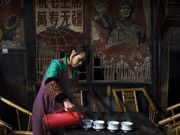

(Photo by Wang Kaihao/China Daily)
After the plastering is done, the gathered people use elm sap to polish the material and coat it with rape oil to make the surface smooth and water-proof.
This process dates back to the Tang Dynasty (AD 618-907).
"As this method is very time-consuming, ordinary Tibetans no longer use it for their homes," says Champa Tsering, director of the Shannan cultural heritage bureau.
"But we follow the tradition for the monastery."
The renovation of the main temple of the monastery began in April, though a three-year rehabilitation of its auxiliary structures was completed in 2015.
In the 1980s, the monastery was renovated using cement.
 |  |
Day|Week

 Who Will Fit The Chinese Roles In Game Of Thrones?
Who Will Fit The Chinese Roles In Game Of Thrones? China's Hubei Shennongjia added to World Heritage List
China's Hubei Shennongjia added to World Heritage List Cute Dog At Fruit Stand Becomes Latest Internet Sensation
Cute Dog At Fruit Stand Becomes Latest Internet Sensation Thai most beautiful transgender Nong Poy release new photos
Thai most beautiful transgender Nong Poy release new photos Top 10 livable Chinese cities
Top 10 livable Chinese cities The last primitive tribe in China
The last primitive tribe in China China's first intelligent security robot debuts in Chongqing
China's first intelligent security robot debuts in Chongqing A Total of 3,552 Subscribers Vanish In Two Days; YouTube Closes All Doors to Users’ Inquiries
A Total of 3,552 Subscribers Vanish In Two Days; YouTube Closes All Doors to Users’ Inquiries Out of this world! Futuristic UFO-shaped yacht has its own garden and a stunning underwater viewing deck
Out of this world! Futuristic UFO-shaped yacht has its own garden and a stunning underwater viewing deck An old tea house in Chengdu
An old tea house in Chengdu